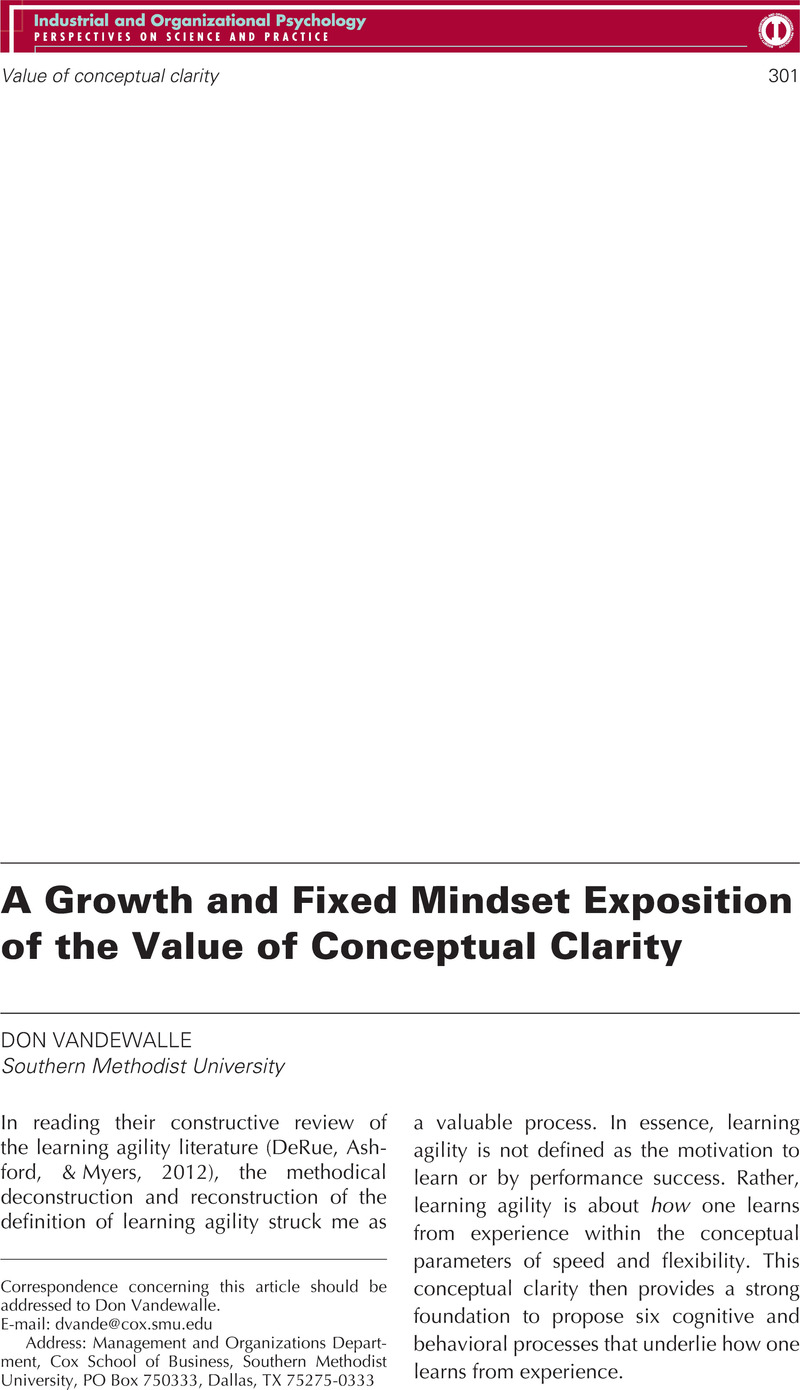Crossref Citations
This article has been cited by the following publications. This list is generated based on data provided by Crossref.
DeRue, D. Scott
Ashford, Susan J.
and
Myers, Christopher G.
2012.
Learning Agility: Many Questions, a Few Answers, and a Path Forward.
Industrial and Organizational Psychology,
Vol. 5,
Issue. 3,
p.
316.
Love, Peter E. D.
and
Smith, Jim
2016.
Toward Error Management in Construction: Moving beyond a Zero Vision.
Journal of Construction Engineering and Management,
Vol. 142,
Issue. 11,
류혜현
and
Oh,Hun-Seok
2016.
Learning agility: Issues and Challenges.
The Korean Journal of Human Resource Development Quarterly,
Vol. 18,
Issue. 4,
p.
119.
Özduran, Ali
and
Tanova, Cem
2017.
Manager mindsets and employee organizational citizenship behaviours.
International Journal of Contemporary Hospitality Management,
Vol. 29,
Issue. 1,
p.
589.
Root Kustritz, Margaret V.
2017.
Pilot Study of Veterinary Student Mindset and Association with Academic Performance and Perceived Stress.
Journal of Veterinary Medical Education,
Vol. 44,
Issue. 1,
p.
141.
Howard-Payne, Lynlee
2017.
“The other”: Persistent beliefs regarding HIV risk in South Africa.
Journal of Psychology in Africa,
Vol. 27,
Issue. 1,
p.
18.
Love, Peter E. D.
Veli, Sandra
Davis, Peter
Teo, Pauline
and
Morrison, John
2017.
See the Difference
in a Precast Facility: Changing Mindsets with an Experiential Safety Program
.
Journal of Construction Engineering and Management,
Vol. 143,
Issue. 2,
Tomasi, Stella
Schuff, David
and
Turetken, Ozgur
2018.
Understanding novelty: how task structure and tool familiarity moderate performance.
Behaviour & Information Technology,
Vol. 37,
Issue. 4,
p.
406.
Rodriguez, Michael
Boyer, Stefanie
Fleming, David
and
Cohen, Scott
2019.
Managing the Next Generation of Sales, Gen Z/Millennial Cusp: An Exploration of Grit, Entrepreneurship, and Loyalty.
Journal of Business-to-Business Marketing,
Vol. 26,
Issue. 1,
p.
43.
Tak, Jewoon
김종훈
and
Je-Goo Shin
2019.
The Effect of Participative Decision Making on Helplessness: The Mediating Effect of Psychological Contract Violation and the Moderating Effect of Mindset.
The Korean Journal of Human Resource Development Quarterly,
Vol. 21,
Issue. 3,
p.
77.
Jordan, Samantha L.
Wihler, Andreas
Hochwarter, Wayne A.
and
Ferris, Gerald R.
2019.
Research in Personnel and Human Resources Management.
Vol. 37,
Issue. ,
p.
53.
Foelsing, Jan
and
Schmitz, Anja
2021.
New Work braucht New Learning.
p.
245.
Crossan, Mary
Ellis, Cassandra
and
Crossan, Corey
2021.
Towards a Model of Leader Character Development: Insights From Anatomy and Music Therapy.
Journal of Leadership & Organizational Studies,
Vol. 28,
Issue. 3,
p.
287.
Plimmer, Geoff
Berman, Evan M.
Malinen, Sanna
Franken, Esme
Naswall, Katharina
Kuntz, Joana
and
Löfgren, Karl
2022.
Resilience in Public Sector Managers.
Review of Public Personnel Administration,
Vol. 42,
Issue. 2,
p.
338.
Vinesian, Gresika Tabitha
and
Sari, Reza Lidia
2023.
Pengaruh Growth Mindset dan Resiliensi terhadap Learning Agility pada Karyawan Startup Company.
Buletin Riset Psikologi dan Kesehatan Mental (BRPKM),
Vol. 3,
Issue. 1,
p.
92.
Yang, Wa
Zhu, Jinqiang
Xu, Shiyong
Liu, Yanjun
Luo, Dongying
Wang, Yixiao
and
Yu, Jia
2023.
How job complexity fosters employee creativity: a contextualized growth perspective and the mechanism of feedback-seeking.
European Journal of Training and Development,
Vol. 47,
Issue. 7/8,
p.
830.
Chadwick, Ingrid C.
and
Dawson, Alexandra
2024.
From imposter fears to authenticity: a typology of women entrepreneurs.
Small Business Economics,
Vol. 62,
Issue. 3,
p.
1025.
Xiao, Mengtian
Xu, Yingqing
and
Xiao, Qijie
2024.
How perceived team virtuality affects individual knowledge hiding in teams: unraveling the paradox when heads meet hearts.
Information Technology & People,
Milani, Roberta
Sommovigo, Valentina
Ghirotto, Luca
and
Setti, Ilaria
2024.
Individual differences in learning agility at work: A mixed methods study to develop and validate a new scale.
Human Resource Development Quarterly,
Vol. 35,
Issue. 4,
p.
455.



